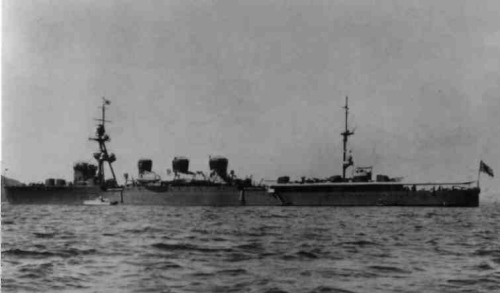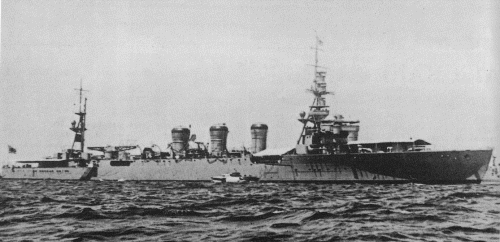
NAVYPEDIA
 Support the project with paypal
Support the project with paypal
Photo

Kuma
Ships
| Name | No | Yard No | Builder | Laid down | Launched | Comp | Fate |
|---|---|---|---|---|---|---|---|
| 球磨 [Kuma] | Sasebo K K | 29.8.1918 | 14.7.1919 | 31.8.1920 | sunk 11.1.1944 | ||
| 多摩 [Tama] | Mitsubishi, Nagasaki | 10.8.1918 | 10.2.1920 | 29.1.1921 | sunk 25.10.1944 | ||
| 北上 [Kitakami] | Sasebo K K | 1.9.1919 | 3.7.1920 | 15.4.1921 | damaged 24.7.1945, never repaired | ||
| 大井 [Oi] | Kawasaki, Kobe | 24.11.1919 | 15.7.1920 | 3.10.1921 | sunk 19.7.1944 | ||
| 木曾 [Kiso] | Mitsubishi, Nagasaki | 10.6.1919 | 14.12.1920 | 4.5.1921 | sunk 13.11.1944 |
Technical data
| Displacement normal, t | 5500 |
|---|---|
| Displacement full, t | 5832 |
| Length, m | 158.5 wl 162.2 oa |
| Breadth, m | 14.2 |
| Draught, m | 4.80 |
| No of shafts | 4 |
| Machinery | 4 sets Mitsubishi-Parsons-Gihon geared steam turbines, 12 Kampon boilers Oi: 4 sets Brown-Curtis geared steam turbines, 12 Kampon boilers |
| Power, h. p. | 90000 |
| Max speed, kts | 36 |
| Fuel, t | coal 350 + oil 1260 |
| Endurance, nm(kts) | 4000(14) |
| Armour, mm | belt: 63, shields: 20, deck: 29 (45 over magazines), CT: 51 - 25 |
| Armament | 7 x 1 - 140/50 3-shiki, 2 x 1 - 76/40 3-shiki, 2 x 1 - 6.5/115, 4 x 2 - 533 TT, 48 mines |
| Complement | 450 |
Standard scale images

Tama 1941

Oi 1941

Oi 1922

Tama 1941
Graphics
Project history
Five ships of Kuma class were built under the FY1917 Programme within the limits of the "8-4" Programme. According to it it was provided to supplement IJN with six 3500t ships of "improved Tenryu" class and three 7200t "scouts", but when in Japan plans of Americans about building of 10 Omaha class cruisers became known (originally: 7100t, 35kts, 8 152mm guns), late 1917 the Programme was corrected. The project of "scouts" have decided to redesign (that moved their building for later time), and instead of too weak against American ships 3500t "improved Tenryu" to create the design of multipurpose 5500t cruisers, capable to fulfil function of scout and leader. In total building of eight such ships which have received a designation as a cruiser of "medium model", and one more experimental ship of "small model" (future Yubari) was provided.
New 5500t cruisers design based on drawings of Tenryu. Displacement growth was expended to increase of machinery power (from 51000hp to 90000hp), that has allowed to raise speed to 36kts. Usage of so powerful machinery has forced to transfer from 3-shaft to 4-shaft scheme. Boilers number has increased to 12, and, as well as on a prototype, two had mixed firing. Though the number of 140mm guns has increased to seven, the arrangement scheme has appeared is far from ideal: six guns could participate in side salvo (because of installation of No3 and No4 guns aside on forecastle break), and turn angles of No2, No5 and No6 guns have been strongly limited. For the sake of justice, it is necessary to notice, that contender of 5500t Japanese cruisers, Omaha, originally (before project redesigning) can use in side salvo only half from eight guns only. Additionally cruiser had 2 76mm AA guns and 4 twin 533mm TT, placed aside. Besides, ships could take also mines.
Of eight scheduled to building under the "8-4" Programme cruisers five (Kuma class) were built on an original design, three more concerned to advanced Nagara class.
In 1935-1938 on all five ships of this class boilers were transferred from mixed firing to oil. Then for stability raise works on reduction of the upper weight are conducted, besides, ships received 103-200t of solid ballast (more 202-289t of liquid ballast were carried in double bottom space). Total displacement has come nearer to 8000t, and maximal speed decreased to 32kts.
In 1941 Kitakami and Oi have passed one of the most unusual conversions (former at Sasebo, latter at Maizuru) in which course have been converted to "torpedo cruisers". The project of conversion, developed in autumn 1938, provided replacement of existing armament by 4 twin 127mm DP mounts (on two fore and aft), 4x2 25mm AA MGs and 11 (on five aside and one in a centreline) quadruple 610mm TT for well-known "long lances" oxygen torpedoes of type93.
The initial plan supposed to convert to "torpedo cruisers" three ships: Kitakami, Oi and Kiso. Shortage of 127mm mounts and 610mm TTs have served as a cause of a failure from conversion of Kiso, and on two remaining ships the amount of works has been shrunk: fore group of 140mm guns was retained, and number of TTs was shrank from 11 to 10 (at the expense of abandoning from TT on centreline).
For aside placing of massive torpedo mounts on about 60m length (from forecastle break to aft ER bulkhead) the deck was expanded at the expense of sponsons to 17.5m.
In summer 1942 it has been decided to convert both "torpedo cruisers" to fast transports. In August-September they have passed conversion in which course number of TTs was shrunk to six (6х4), and exempted space used for placing of two Daihatsu type landing crafts. Number of 25mm MGs (became 2х3 and 2х2) has simultaneously been increased, and DCT were mounted on the stern (18 DC totally).
Later Kitakami and Oi changed 140mm guns on 2 twin 127mm/40 DP mounts. Besides, on Kitakami number of TT have shrunk to two (2х4), and exempted space used for placing of six Daihatsu type landing crtafts.
In August, 1944-January, 1945 during repair of battle damages received as a result of torpedo hit, Kitakami was converted to Kaiten human torpedo carrier. Such eight torpedoes took places on sponsons and were floated on a stern shipway (this slipway approximately on 1m increased hull length). They were taken aboard by 20t derrick removed from seaplane carrier Chitose after her conversion to aircraft carrier. Remained 610mm TT were removed, as well as 140mm guns. Instead of the latter new 2x2 127mm/40 DP mounts were installed. During conversion cruiser lost two shafts and turbine units from damaged engine rooms, power has fallen to 35000hp, and speed to 23.8kts. Standard displacement has decreased to 5640t.
Ship protection
Main belt (7.32m high) protected only machinery, its upper part (73.2x3.00m) was 51mm thick and lower part (68.3x4.32m) 63mm. 29mm flat deck connected with upper edge of belt. CT had 51mm sides and 25mm roof.
Modernizations
1932 - 1934, Kuma, Tama: + 1 catapult, 1 seaplane
1934, Tama: - 2 x 1 - 76/40; + 2 x 2 - 13.2/76
1934 - 1938, all: - 2 x 1 - 6.5/115; + 2 x 1 - 7.7/80
1935 - 1938, all: boilers were converted to oil, maximal fuel stowage was 1600t, solid and liquid ballasts were added. Full displacement increased to 8000t and maximal speed fell to 32kts.
1937, Kiso: - 2 x 1 - 76/40; + 2 x 1 - 12.7/62
1937 - 1940, Kuma, Kitakami, Oi: - 2 x 1 - 76/40; + 2 x 2 - 25/60 96-shiki
1937 - 1940, Tama: - 2 x 2 - 13.2/76; + 2 x 2 - 25/60 96-shiki
1937 - 1940, Kiso: - 2 x 1 - 12.7/62; + 2 x 2 - 25/60 96-shiki
1941 - 1942, all: - 2 x 1 - 7.7/80
1941, Kitakami, Oi: were converted to torpedo cruisers with data as follows: 5780 / 7800t; 162.2x17.5x5.60m; 4 x 1 - 140/50 3-shiki, 2 x 2 - 25/60 96-shiki, 10 x 4 - 610 TT, large 60m sponsons were fitted.
8 - 9.1942, Kitakami, Oi: - 4 x 4 - 610 TT; + 2 x 3 - 25/60 96-shiki, 2 DCR (18), 2 landing craft of Daihatsu type.
4/1943, Kiso: + 2 x 2 - 25/60 96-shiki, 1-shiki 2-go radar
5/1943, Kiso: + 1 x 1 - 75/44 88-shiki
11/1943, Kuma: - 1 x 1 - 140/50 (no 5), catapult and seaplane; + 2 x 3 - 25/60 96-shiki
11/1943, Tama: - 2 x 1 - 140/60 (No 5, 7), catapult and seaplane; + 1 x 2 - 127/40 89-shiki, 4 x 3 - 25/60 96-shiki, 6 x 1 - 25/60 96-shiki, 2 x 1 - 13.2/76, 1-shiki 2-go radar
3/1944, Kiso: - 2 x 1 - 140/50 (No 5, 7), 1 x 1 - 75/44, 2 x 2 - 25/60 96-shiki; + 1 x 2 - 127/40 89-shiki, 3 x 3 - 25/60 96-shiki, 6 x 1 - 25/60 96-shiki, 1 x 2 - 13.2/76
6/1944, Tama: + 1 x 3 - 25/60 96-shiki, 2 x 2 - 25/60 96-shiki, 12 x 1 - 25/60 96-shiki, 5 x 1 - 13.2/76, 2 DCR (36), 2-shiki 2-go radar
6/1944, Kiso: + 1 x 3 - 25/60 96-shiki, 2 x 2 - 25/60 96-shiki, 12 x 1 - 25/60 96-shiki, 8 x 1 - 13.2/76, 2-shiki 2-go radar
1/1945, Kitakami: length oa increased to 163.0m by stern chute for human torpedoes of Kaiten type, torpedoes were handled by large 30t derrick. Displacement was 5640 / 7009t. All old armament was removed, cruiser was armed as follows: 2 x 2 - 127/40 89-shiki, 12 x 3 - 25/60 96-shiki, 31 x 1 - 25/60 96-shiki, 2 DCT, 2 DCR (24), 8 Kaiten human torpedoes, 2x 3-shiki 1-go, 2-shiki 2-go radars. 2 shafts and half of boilers were removed, ship can obtain 23.8kts speed with 35000hp of machinery power.
7/1945, Kitakami: + 27 x 1 - 25/60 96-shiki
Naval service
Kuma 11.1.1944 was sunk at Penang by British submarine Tally Ho. Oi 19.7.1944 was sunk S off Hong Kong by US submarine Flasher. Tama during battle in Leyte Gulf 25.10.1944 was damaged by US carrier aircraft and sunk this day SE off Engano by US submarine Jallao. Kiso 13.11.1944 was sunk by US carrier aircraft of TF.38 W off Manila, her wreck was salvaged in 1955 and scrapped in 1956.
Kitakami 27.1.1944 was hard damaged by British submarine Templar, temporarily repaired by late July, 1944. 24.7.1945 she was hard damaged at Kure during raid of US carrier aircraft of TF.38. 28.7.1945 she has received new damages during next raid of TF.38 aircraft and was never completely repaired. She was used for repatriation after war and stricken only 30.11.1945.
 HOME
HOME FIGHTING SHIPS OF THE WORLD
FIGHTING SHIPS OF THE WORLD JAPAN
JAPAN CRUISERS
CRUISERS KUMA light cruisers (1920 - 1921)
KUMA light cruisers (1920 - 1921)

